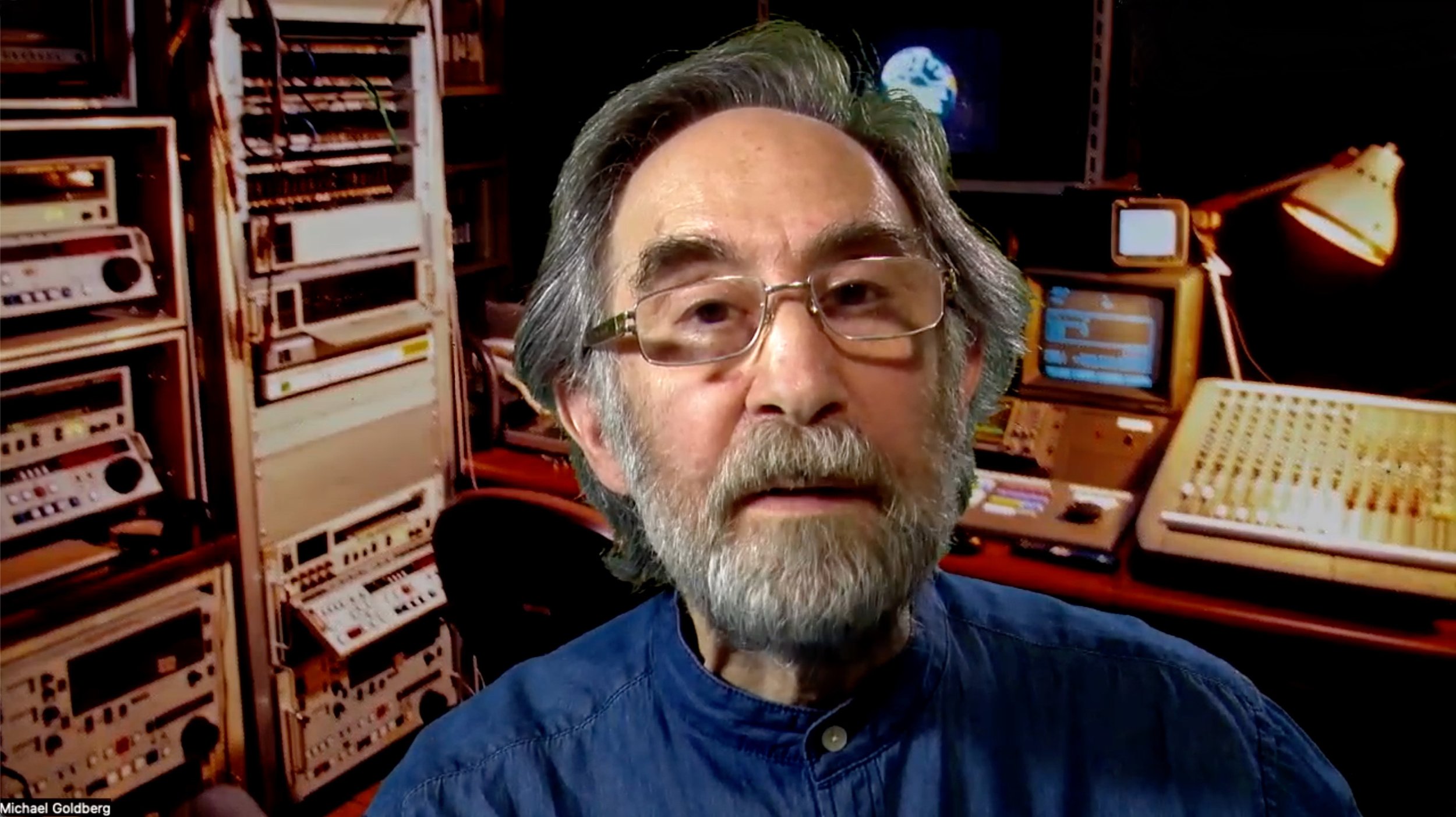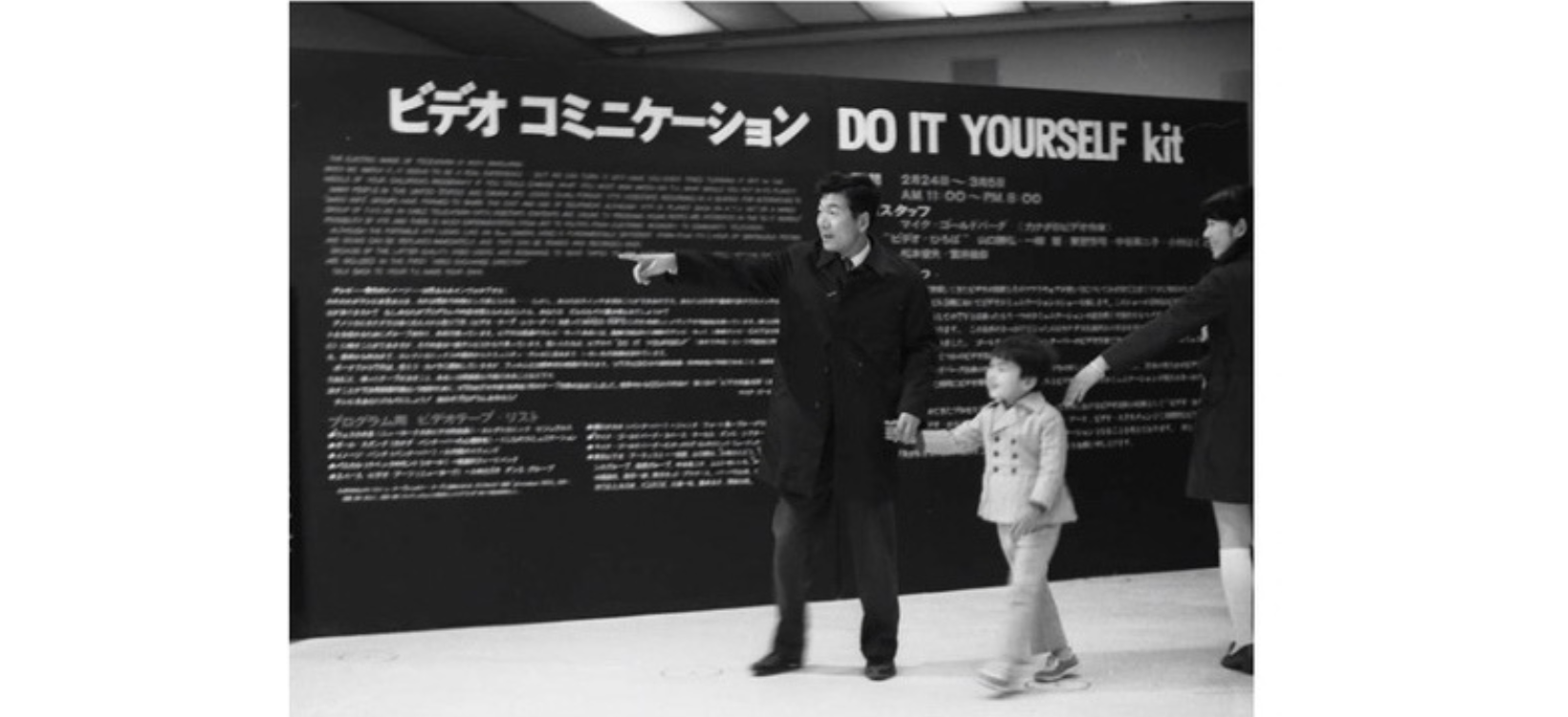1972 Performance Records: Gann Matsushita, Michael Goldberg, Tokyo Kid Brothers
From Michael Goldberg, Tokyo Kid Brothers Rehearsal (1972).
This June, we’re thrilled to present a series of records organized around a set of 1972 reels from the collection of Michael Goldberg, a Canadian video artist foundational to the early days of video art in Japan. Digitized in 2023 as part of our Community of Images project, the records feature Video Hiroba affiliate and conceptual artist Gann Matsushita, a rehearsal of the avant-garde theater troupe Tokyo Kid Brothers filmed handheld by Goldberg, and other scenes captured by Goldberg with Matsushita around Tokyo.
In kind partnership with VIVO Media Arts Centre and Gann Matsushita, we are also delighted to present a little-seen record of his 1972 performance piece Glacier Project, shot on a volcanic mountain in Fukushima. The quiet film sees Matsushita lay white sheets on the side of a summer mountain, then repeating the action when it is covered with snow. It ends with footage of his uncle playing the flute.
Michael Goldberg first visited Tokyo in 1971, and was in contact with Fujiko Nakaya through their mutual involvement in the group Experiments in Arts and Technology (E.A.T.). Along with Nakaya and Katsuhiro Yamaguchi, he was instrumental in the organization of Video Communication: Do-It-Yourself Kit, the first-ever video art exhibition in Japan, an instrumental event in transpacific video history which spawned the collective Video Hiroba.
During his early days in Tokyo, Goldberg met Matsushita and they became lifelong friends. Through Ko Nakajima, he met fellow artist and Video Earth member Mihato Taura, whom he would later marry. It was through Fujiko Nakaya that Goldberg was allowed to film the rehearsal of Tokyo Kid Brothers in 1972. An underground theater troupe run by former Tenjo Saijiki member Higashi Yutaka (1945-2000), they achieved cult popularity in the early 1970s and performed in New York, Amsterdam and London. At the time, their musical director was Kazuhiko Kato (1947-2009) who would go on to form the Sadistic Mika Band. We are grateful to Makoto Inoue, Itsuro Shimoda and Kohei Ando who helped us to facilitate the first ever showing of this enjoyable record of theatrical history.
CCJ’s Community of Images programming is generously supported by Pew Center for Arts and Heritage, the Andy Warhol Foundation, the Toshiba International Foundation and the Pennsylvania Council on the Arts’ Preserving Diverse Cultures grant.
Become a member for just $5 a month to access our monthly programs, and share your thoughts on our screenings with us via Twitter, Instagram or Letterboxd.
THE PROGRAM WILL BE AVAILABLE FOR VIEWING ON CCJ’S VIEWING PLATFORM.
This Members Viewing program is supported, in part, by a grant from the Toshiba International Foundation.
Program
Michael Goldberg & Gann Matsushita, 1972 Tokyo B-roll, 1972, 17:06min, video, black and white, sound
Explorations and experiments around Tokyo by Michael Goldberg and Gann Matsushita. Starting with walls of televisions in Akihabara, Tokyo's electronics district, the focus turns to Gann and others experimenting with the Sony Portapak in various public spaces including the area of Yoyogi Park around the 1964 Olympic Stadium. The raw "b-roll" footage captures the media environment of 1970s Tokyo as well as the sense of innovation, possibility and play that opened up around the first portable video cameras. The Portapak’s recorder could be worn on the body in a large satchel, as sported by those in the video.
Gann Matsushita, Glacier Project, 1972, 22:06 min, video, black and white, sound
This performance piece for video by Gann Matsushita is from the collection of the VIVO Media Arts Centre. It stems from Matsushita's feelings about facing the forces of nature, particularly the wind, as an avid sailer and skier (All-Japan Downhill Ski Champion at 19). Filmed on volcanic Mt. Adatara in Fukushima by his long-time collaborator Takahiro Maruyama, it starts by showing the artist lay large, rectangular white sheets (inspired by sails) on the side of the mountain in summer. In a gesture evoking poignant impermanence, he repeats the action when the landscape is covered with snow. The film ends with a peaceful interior scene of his uncle playing the flute. The video was kindly edited for the current screening by VIVO Media Arts Centre and Michael Goldberg.
Michael Goldberg, Tokyo Kid Brothers Rehearsal, 1972, 32:50min, video, black and white, sound
A rehearsal for the musical「西遊記」or “The Moon is East, the Sun is West” by Tokyo Kid Brothers. Based on the 16th-century Chinese epic Journey to the West, the show was performed at Yotsuya Public Hall in March/April 1972, and later in the year at various theaters in London, where spectators praised its “maniacal energy.” [1] This record was taken in Tokyo by Michael Goldberg, who was invited by fellow video artist Fujiko Nakaya to watch the rehearsal. It sees the cast members perform songs from the first half of the show, including “Pilgrimage Song”(巡礼歌) and “Motorbike” (モーターバイク), taking direction from the troupe’s leader Higashi Yutaka.
The live London performance was pressed into a record issued in 1972. The show’s musical director was Kazuhiko Kato who later formed the Sadistic Mika Band.
The cast of the Tokyo performance included Chihiro Nara, Shoichi Saito, Setsuko Nakagawa, Misho Fukamizu, Eiji Kusuhara, Yoshiko Fujisawa, Fumiko Kuniya, Laurie Kirishima, Akemi Otsuka, Yukiko Tsutsumi, Yuko Yoshida, Mai Yoshida, Yoichiro Masaki, Yoshio Sugimoto, Satoko Inoue and Shugo Yamazaki.
The crew included Higashi Yutaka (director), Yoko Shimoda (production), Kazuhiko Kato (music), Naoto Kani and Shun Takagi (stage management), Hiroyuki Fukubayashi (lighting), Kayoko Nakura (choreography), Ryoichi Enomoto (art), and Hirofumi Yamada, Nobuo Saito, Kazuo Endo, and others (performance).
Michael Goldberg
Michael Goldberg (b. 1945, Canada) was a pioneer of video and an instrumental figure in nurturing its early days in Vancouver and Japan. Friendly with Fujiko Nakaya through the organization E.A.T. (Experiments in Art & Technology), he first came to Japan in 1971 on a grant from the Canada Council, and in 1972 along with Nakaya and Katsuhiro Yamaguchi organized Japan's first video art exhibition. Held at the Sony building in Ginza, Tokyo, the exhibit-cum-workshop was entitled Video Communication: Do It Yourself Kit, and would become the catalyst for the formation of the video collective Video Hiroba. Goldberg also co-founded the VIVO Media Arts Centre in Vancouver. Today he resides in Japan, and remains active as a producer and director of documentaries and other video forms through his company International Videoworks, Inc.
Tetsuo “Gann” Matsushita 松下 哲雄
Gann Matsushita was recognized with several major artist awards, including at the pioneering Tokyo Biennale of 1970 and from the Museum of Modern Art, Kamakura in 1971. Concurrently, he was leader of the students' protest movement at Tama Art University (or Tama-bi) for three years as Chair of the university's chapter of 全学共闘会議 (The All-Campus Joint Struggle Committees,) a.k.a. Zenkyōtō. He was involved with early video culture in Tokyo, including (in 1972) "VIDEO COMMUNICATION - Do It Yourself Kit", and "Video Week: Open Retina Grab Your Image", an exhibition organized by Video Hiroba and the American Center, Tokyo. Matsushita coordinated the symposium component of the latter, bringing together panelists including Arthur Ginsberg and Mits Kataoka. In August 1972, he relocated to Vancouver, British Columbia, asking fellow video artist Michael Goldberg, whom he had met in Tokyo, to meet him at the airport. He remained in Canada for several years, making video works and authoring a paperback entitled The Canada That No-One Has Written About (誰も書かなかったカナダ). Several of Gann’s works are held in the collection of the VIVO Media Centre, partly after his participation in the 1973 MATRIX International Video Exchange Conference organized by Goldberg and Trish Hardman, where participants were asked to donate a videotape in lieu of an admission fee.
Tokyo Kid Brothers 東京キッドブラザーズ
Tokyo Kid Brothers was formed when in 1968 Higashi Yutaka, founding member of the theater troupe Tenjō Sajiki, split off from Terayama’s group to form his own experimental musical theater collective along with seven founding members: Itsuro Shimoda, Kenkichi Sato, Noboru Mine, Yoko Kaji, Ryusaku Fukami, Yukiko Kobayashi, and Akio Takahashi. Their first performances were at a Shibuya theater named “Hair”, where they staged original musicals that combined rock music, avant-garde strategies and political critique. With a shifting roster of members and cast, in the early 1970s the Kid Brothers performed both in Japan and abroad, including in New York (at the Off-Broadway theater La Mama in 1970 and again in 1974, and even appearing on US television), Amsterdam (Shaffy Theater, 1971) and London (Oval House, Royal Court & Hampstead Theaters, 1972). The troupe’s activities continued throughout the 1980s, at which time one member was the future novelist and romantic partner of Yutaka Miri Yu, and the 1990s with the establishment of the Tokyo Kid Brothers Second Company. The group’s activities ended in 2000, with Yutaka’s death.
Introduction by Mia Parnall
Community of Images: Japanese Moving Image Artists in the US, 1960s - 1970s
Community of Images: Japanese Moving Image Artists in the US, 1960s-1970s will be an exhibition of experimental moving images created by Japanese artists in the U.S. during the 1960s and 70s, an area that has fallen in the fissure between American and Japanese archival priorities. Following JASGP's Re:imagining Recovery Project and its mission to support and engage diverse audiences through Japanese arts and culture in collaboration with local organizations, this project aims to discover, preserve, and present film and video works and performance footage by Japanese filmmakers and artists to the wider public.
We have partnered with the University of the Arts, and will present this exhibition at the Philadelphia Arts Alliance in June - August 2024.
The project and its online programming is generously supported by the Pew Center for Arts and Heritage & the Andy Warhol Foundation, the Toshiba International Foundation and the Pennsylvania Council on the Arts’ Preserving Diverse Cultures grant.








